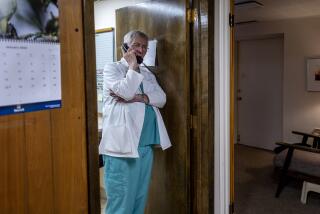Abby J. Leibman
Abby J. Leibman is kicking back these days. After 12 years of fighting the good fight on behalf of women and girls, she will soon step down as the executive director of the California Womenâs Law Center.
Leibman, 44, is one of the nonprofit centerâs founding directors and has been its most public face and passionate advocate. The centerâs mix of litigation, advocacy and education is unique in California.
Under her leadership, the law center has developed model sexual-harassment policies that have been adopted by government agencies and private firms; prodded the Los Angeles Police Department to address the gender bias within its force; compelled the state to issue regulations governing sexual harassment in schools and sex discrimination in sports; pushed local governments into establishing child-care options for women transitioning off welfare; and counseled women who have suffered discrimination at work or in obtaining medical care because they had breast cancer.
But come July, Leibman, who earned her law degree at UC Hastings College of Law in San Francisco, will leave to pursue new challenges, still undefined, and to spend more time with her two school-age children. Meanwhile, the 11-person law center, with an operating budget of $1.2 million, is searching for Leibmanâs replacement, someone who can âmove it to the next plateau . . . as a significant leadership organizationâ nationally.
Although she has a reputation for being outspoken and impatient, Leibman can be disarmingly informal. The law center was born in 1989 after Leibmanâs stint at Public Counsel, where she directed a project on child-care law. She and her colleagues noticed the absence in Southern California of a one-stop center to go to for help with womenâs rights issues.
Her deep roots locally--Leibman grew up in Chatsworth--and a strong web of close friends and family have helped her cope with a wrenching family loss: Her twin sister, Nina Donney, was murdered by her estranged husband nearly six years ago, and Leibman has raised Ninaâs son and daughter ever since. When time permits, Leibman decompresses with movies and long walks.
Leibman was interviewed in the law centerâs offices near downtown.
*
Question: President George W. Bush says he wants to put children and families first. Many progressives and moderates say the same thing. If everyone wants the same goal, are there ways to accomplish it that everyone could agree with?
Answer: Iâd like to think that when people use those words, they mean the same thing [but] I donât believe they do. There is a prism through which people look at what they think is best for others that is framed by their own experience. And that often means a goal that isnât consistent with what others would see as whatâs in the best interests of a community or the country.
Q: In Bushâs case?
A: There is a layer of morality [in] the current administration that was made most visible by the [White House Office of Faith-Based and Community Initiatives] and some comments the president made in creating [it]. For many people, the notion that morality and organized religion are the sole ways in which to elevate families is anathema. That is not what the United States is about. . . . There is a tremendous fear that the relationship and the links drawn between religion, government and family will result in the control of women.
Q: In what ways?
A: There will be a lot of pressure encouraging teenagers to choose to birth babies rather than seek abortions. There will be places where women will be incapable of making a choice about their family planning, either because they canât get access to emergency contraception or they canât get access to contraceptives. Or they canât get an abortion because they simply cannot find a provider, because all the health care in their community is being run by faith-based institutions that donât believe in that. That clearly limits our choices. That feeds back into discussions about the size of your family, your ability to economically support that family and your own personal life and future.
Q: Have you changed the centerâs focus because of your experiences as a parent?
A: We try really hard not to extrapolate from our own anecdotal experience, but we may use it as the catalyst for investigating something we might not have perceived. . . . The most recent example is a project we call Murder at Home. My sisterâs murder was the inspiration for this project, but we didnât undertake it until it became clear to us that her experience was not unique. Itâs an exploration of the way the media treat the murders of women by their intimate partners, and the way the criminal justice system treats them. Some of our hypotheses and assumptions are that these murders are treated differently from those between strangers. Without placing any value judgment on that, it provides an opportunity for us to present a case study to the justice system and to the media to say, at least you ought to be aware that youâre doing this.
Q: What is the difference?
A: There is a greater sense of vilification of the victim. . . . So that if you look at the circumstances of the homicide, you would say, this is a very brutal homicide . . . and yet youâll have the judge give instructions to a jury that speak in terms of family tragedy: This is sad for everyone. Yet, if it was a stranger who had crawled through a window and stabbed somebody 27 times, the language, the hyperbole that would surround [the murder] would be very different. . . . There are also a number of single parents on our staff, and this has created a level of urgency in responding to welfare reform . . .
Q: On welfare reform, what are the law centerâs goals?
A: Our biggest challenge is . . . recognition that the United States lacks an adequate infrastructure to support single-parent families, most of which are headed by women. . . . Thereâs a presumption about what it takes to manage your daily life and then move yourself out of poverty that is completely out of sync with what is real. I once was asked what I would do if I had the power to implement any type of welfare reform. I said I would start by doubling the basic welfare grant. The reaction I got caused me in the future not to [repeat] it without a certain number of disclaimers and parentheticals. But I firmly believe that thatâs true. Without the financial wherewithal to feel safe, to feel that you know where your next meal is coming from, that you arenât making choices between paying your electricity bill and the rent, or buying sneakers, you cannot create an atmosphere in which you have the opportunity to encourage good choices for your children and for yourself. If you are frightened that youâre going to be on the street the next time somebody gets a catastrophic illness, you canât function. . . . And when you see that the people who are most affected by this are households headed by women, you have to start asking yourselves, why is that happening and what do women need? What have we ignored?
Q: What have we ignored?
A: Weâd look at child care, issues of transportation, health care. . . . These are questions that seem to always be addressed outside the context of what it means to have to support yourself. And when you put women into a situation where you say to them, youâre going to have to be in the paid work force, well, do you also say they are going to be getting health insurance and paid vacations and comp time and time off when a child is sick? Probably not. And while much has been made of the fact that you have to get paid at least something above minimum wage, that isnât going to buy those things. . . .
Sometimes our zeal to gender-neutralize everything causes us to come up with solutions that are inappropriate and unworkable. The first versions of the family and medical leave bills said that you had to work for 12 consecutive months at a particular site within a certain distance with a certain number of employees. That meant that every teacher in the United States was ineligible to take a family on medical leave because they . . . are only actually at their work site for 10 months consecutively out of the year. . . . Well, what is one of the single-most female-dominated occupations in the U.S.? Teaching.
Q: Bushâs father vetoed family leave twice. Yet, it wasnât an issue in the 2000 campaign. Have attitudes changed among people who didnât initially support it?
A: Iâm not sure because I donât think very many people are taking it. . . . All the worst-case scenarios did not come to be because people didnât avail themselves of [it] in the numbers that advocates had hoped. In part, thatâs because itâs unpaid leave . . . Also, people who are in a position to afford it financially, psychologically will not take it because there is a perception on their part that they will lose ground in their career.
Q: Where do you see the most progress for women and girls since the founding of the law center 12 years ago?
A: In higher education. Far more women have reaped the benefits of Title 9 over the last 12 years than in almost any other area in which we work. . . . There are still some serious issues about the underrepresentation of women of color, but in terms of its impact, Title 9 has [brought about] cultural and legal changes that have outstripped our expectations. . . . The other area in which I think thereâs been a tremendous explosion of recognition . . . is domestic violence. Since we started the law center, there have been dozens of new laws passed [across the nation] that reflect a growing understanding that itâs a crime to hit your wife. There is little, if any, public support or sympathy for men who hit their wives. And that was not so true 12 years ago.
Q: What are the biggest priorities at the national level?
A: We need civil rights legislation that protects women and girls from discrimination in contexts other than education and employment. Right now, your federal rights are limited to those. In park and recreation programs, in private institutions that run sports programs or enrichment programs, none of those programs are covered by federal civil rights laws. We need to fill in the gaps, especially since more and more programs and activities [for children] are provided through the private, nonprofit sector and delivered in ways we canât characterize as education.
Q: What about at the state level?
A: In California, one of our biggest challenges remains preserving access to adequate health care for women and girls. The explosion of religious-based health care [for women] in this state is seriously limiting womenâs choices.
Q: Are you talking specifically about reproductive issues?
A: To some extent, yes, although reproductive health care is huge for women. Itâs not just about abortions. Itâs also often the way in which women get other health care, itâs how they become aware that they have other health problems. For many women, the only physicians they see are their gynecologists. If you are in a situation in which you have no access to a gynecologist, you may [not] get comprehensive health care.
Q: As you look back, who stands out as someone who really touched you?
A: The very first year we opened the law center, there was a woman named Maria Navarro; she had called 911 to tell them that her estranged husband was coming over to kill her. She was at a family birthday party, I think, it was in the middle of the day and the 911 operator told her to call back when he got there. And he got there and he killed her. Afterward, somebody else called 911 back. There is a presumption that there was no
immediate threat, that she couldnât judge. But we thought, who knew him better? What would it cost the police to send a patrol [car] to her house? She was the catalyst for much of the way we talked about women because that credibility thing came up over and over. And in very practical terms, this issue of immediate threat has become a part of the future goal work of the law center . . . I never met her . . . [or] her family. But she was a powerful figure in my vision of the work to be done.
More to Read
Get the L.A. Times Politics newsletter
Deeply reported insights into legislation, politics and policy from Sacramento, Washington and beyond. In your inbox three times per week.
You may occasionally receive promotional content from the Los Angeles Times.










